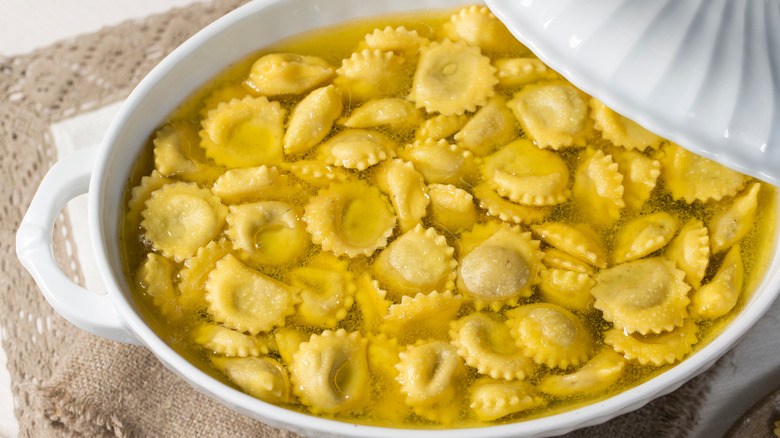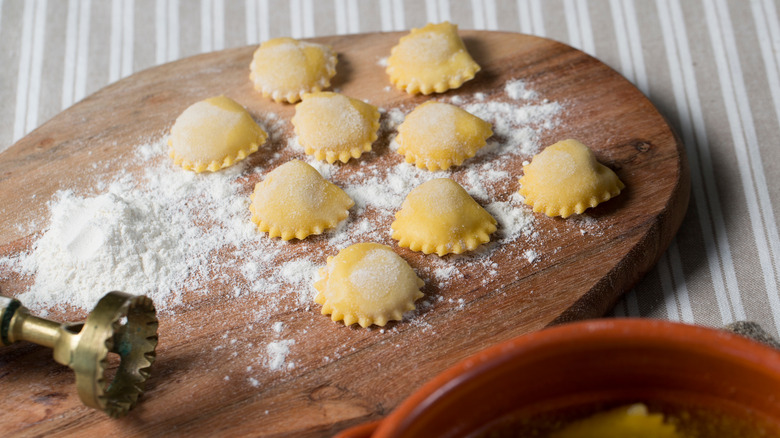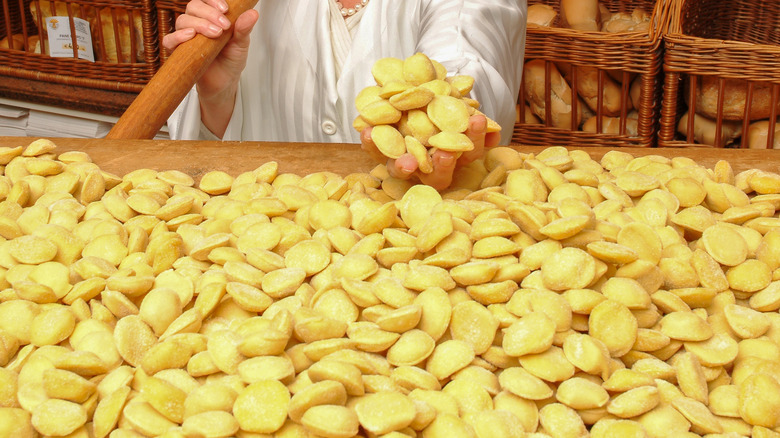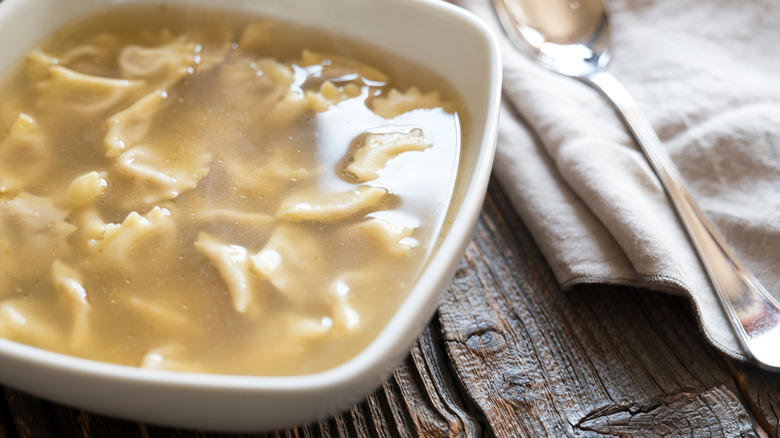Anolini Is The Classic Italian Pasta Served In A Rich Broth
The vast list of Italian pastas goes far beyond the typical types we're used to in the States (i.e. spaghetti, ravioli, penne, etc). Venture to the motherland and you'll find passatelli, which uses Parmigiano Reggiano in the dough; radiatori, an ideal shape for homemade soup; and anolini, which may remind you of tortellini at first glance. While anolini is a type of stuffed Italian pasta, it can have round or serrated edges. And unlike tortellini, ravioli, or other types of filled noodles, anolini is typically served in a specific way during a certain time of the year.
In Parma, a city in northern Italy, anolini is often saved for holiday feasts at Christmas and Easter. If it is enjoyed during the summer (which happens commonly on Sundays), it's still eaten as a hot dish. You'll most often see it served as a part of "anolini in brodo," aka anolini in broth. But what else separates this type of pasta from its stuffed brethren? Let's find out.
Anolini is an ancient Italian pasta
Anolini is a pasta with deep roots in Italian history, as it goes all the way back to 1284, when it was mentioned in the works of a historian who lived in Parma. The word "anolini" means "little rounded stuffed pasta," according to the people of that region. Although it likely came from the Latin word "anulus," meaning "ring," which refers to the device used to cut the noodles into their specific shape. An old recipe from the 1500s explains that the traditional version of the dish involves stuffing the noodles with meat and cooking them in broth.
At first, anolini in broth was a meal made exclusively for royals and the wealthy. Early accounts of the dish pop up in the 18th century, when a Spanish prime minister made it in the Italian style and a duke in Parma enjoyed cooking it himself. As the pasta has evolved past its royal roots, some recipes now omit meat entirely and only include ingredients like, cheese, breadcrumbs, and a rich au jus. Parmigiano Reggiano was also originally part of the filling for anolini. Today, we have Emilia-Romagna, the Italian province encompassing Parma, to thank for the stuffed pastas tortellini, cappelletti, and anolini.
Ingredients for anolini in brodo
To make the pasta dough, all you'll need are eggs, flour, and a pinch of salt. It's important to note that the number of eggs used will not be uniform across all recipes. The ideal dough should be 60% liquid, so depending on the size of your eggs, you may need to adjust as needed or add a little water.
Once the noodles are created and cut, individual families may make anolini in brodo with slightly different ingredients, but there are a few common players you'll typically see. When the dish is served during the holidays in Parma, the filling generally includes beef, breadcrumbs, Parmesan, and a little extra beef juice. The meat can be beef shoulder, chuck roast, stew meat, brisket, or leg meat. However, some recipes branch out and use veal, ground beef, or even chicken. Although veggies don't always make it into the final product, the beef is often cooked in a mixture of onion, celery, and carrots, along with butter and olive oil. It's almost always seasoned simply with salt and pepper. Warming ingredients like red wine, cinnamon, broth, nutmeg, or cloves are also used to cook the meat, along with tomato paste or concentrate.
How to make and serve anolini in brodo
Cooking the beef for the filling is a labor of love, as it can take anywhere from three hours to a day and a half with the meat simmering on low heat. Once the butter and olive oil have softened the onion, celery, and carrots, the beef gets added to a big pot to cook with seasonings, red wine, and water. Tomato paste is usually stirred in halfway through, and more wine can be added so that the meat doesn't burn. The meat and veggies should be completely immersed in liquid. After everything is done cooking, the meat is removed from the pot and chopped or minced in a food processor. Breadcrumbs, cheese, egg, and nutmeg are added to make the filling.
To make the noodles, you'll want to crack eggs into a flour well, then mix everything together. After the dough is kneaded and chilled, you can roll it out, cut it into smaller pieces, and spoon small amounts of filling into each one. There are a few different techniques you can use here. For example, some spoon filling along a dough strip, then cover the whole thing with more dough and cut it into pieces. The important part, which makes the pasta true anolini, is to use a round stamp to shape each filled noodle. Then the anolini can be cooked and served in hot broth, with a dusting of Parmesan on top.



